Creon Upton – 15 February, 2012
ABC has had a good year, a good run, a good innings. They've shown good art, hosted good openings (full of shrieks, synergies and sweat); have brought art folks together in the way such a gallery should.
A little while back, I popped over to Lyttelton to look at two pieces of wood.
This was Tim Middleton’s two-day show splinter in the mind’s eye: having missed the Friday-night opening, I made a special effort the next day to head on out, through the tunnel, to see the art.
So when I was greeted by these chunky off-cuts from a recent wood-chopping competition at the Christchurch A&P show, I came close to a churlish response.
(It is possible that my humour was only saved by the rushes of nostalgia - by the awakened memory of a skinny, slack-jawed boy gaping on in vicarious triumph at the muscular antics of those huge, athletic men - at their white singlets and shining, perfect blades.)
The official word of excuse for Middleton’s wasting of my precious, personal time was that the artist was exploring an “interruption” of his process; that he had chosen to show these lumps of lumber before he cast them in plaster - for some vaguely clever, art-theoretical reason.
I can see some logic to this. Middleton - who is just about to embark on his Honours year in sculpture - seems to be using plaster casts to isolate and capture some kind of stillness in human artefacts (a punching bag, for example, or a table); to bring them to rest in the centre of their being; to - as Heidegger perceived apropos van Gogh’s shoes in The Origin of the Work of Art - presence their equipmentality, their essence as useful things, rather than have that essence used up and destroyed by the fact of the equipment’s usefulness.
But in looking to make plaster casts of wood off-cuts, Middleton moves beyond the artefact (equipment) as subject matter, and into the realm of “the mere thing” (Heidegger actually cites a piece of wood as an example of a mere thing).
And so this is the place to test that action that Heidegger reckoned that art performs - vis, “the happening of truth, the disclosure of beings,” where truth is the irony of discrete beings being apprehended within the “strife” between “world” (naming, basically) and “earth” (intractable totality perhaps).
And by interrupting that process, Middleton seemed to be asking whether the simple (mere) things themselves could presence their being - their truth, their unconcealment - and hence do the work of art. It seems that for Heidegger, the createdness of the work is critical to its ability to disclose beingness (it does this through the disclosure of its own createdness). Have these off-cuts been created? By the axe-man, perhaps, and the work of his blade? By Middleton’s act of transporting them and setting them up in a gallery space? Would perfectly crafted replicas, hewn from the same tree, disclose createdness while the originals could not?
But Heidegger is not interested in questions as to how art does what it does. And he circumvents questions about blocks of wood and urinals and so forth by only dealing with “great” specimens of art. And ultimately his essay represents not much more than a quest to make the seeming profundity of aesthetic experience comprehensible within his broader project of conceptualising in a satisfactory manner the nature of being.
While an important step for him is to dispel the notion of representation itself as a vehicle of truth, he is nonetheless working from an assumption of art as expression: the depth of colour, the textures, the inhabitedness of van Gogh’s shoes speak to his analysis.
On the other hand, Middleton’s plaster-cast artefacts are denuded, ghostly; but their intention, it seems to me, is still nonetheless to arrest us with their making-visible of the mundane, the passed over, the used and thereby used-up.
I suspect, though, that to the extent to which they achieve that, it is through a kind of inversion, a negativing - where the work becomes simply a site - a clearing as Heidegger would have it - for the unconcealment of an-other being.
So one of these white plaster works - a small table, though it also recalled a school desk - sat in ABC’s first room, and one of its feet was supported by a worthless piece of something - a mere thing, a bit of nothing, no more than an abiding, sustaining volume whose function it was to correct a wobble or tilt: one of the most basic pieces of equipment you could turn your mind to.
And not cast in plaster, it was rather a “real” (and mere) thing, abutting against the “art” thing - yet the latter, as a kind of representational vacuum, became a clearing for the unconcealment of that thing, and it, a piece of something (a piece of wood perhaps?) that we all failed to notice ourselves adverting to, became the art in Heidegger’s sense, became the unconcealment of thingness in the strife of being revealed by the negative, by the inversion of thingness, presenting in the ostensible work.
(If Middleton were to hang his plaster-cast punching bag in a gymnasium, the latter might thereby become his work.)
***
So ABC has come to its end - with a group show that is being packed up as I type. And I have wasted most of this review on only one of the fourteen artists being exhibited - and even then I have talked more about his other work than his piece in this show.
But does anyone really mind?
ABC has had a good year, a good run, a good innings. They’ve shown good art, hosted good openings (full of shrieks, synergies and sweat); have brought art folks together in the way such a gallery should.
And they ended on a high note, in my view. A year’s worth of shows were brought together and crammed into one. Fifteen works, working well together in such a small space. Fifteen works that anyone could walk in on off the street and find were worth the ascension of the stairs and the concentration required to focus the eyes.
Here’s the low-down:
Johl Dwyer: A beautiful, luminous and simple piece; framed, painted plaster to appearance; unquestionably presencing the thingliness of things.
Francis Till: A vinyl print window work; a slightly abstract, ambiguous promise - of sex, and escape into a bubbling, watery blue.
Imogen Taylor: A helium-filled “I’m Sorry” balloon, weighed down by a water-filled nothing balloon; the message could be for Christchurch, for ABC, or for the paucity of the artist’s effort; but it created conversation, not least around the question, “Who would give someone an ‘I’m Sorry’ balloon?”
Sebastian Warne: Paring down his ideas, they grow deeper, more compelling; the sickness he seeks spills forth of its own accord as the artist withdraws his hand.
The Silver Bulletin: A design student’s publication; it looks good and generally contains something worth reading - this time a tour diary by Delaney Davidson, someone else being frustratingly clever with a tale of intentional etymology, Frances Martin being whimsical about Emmylou Harris, and Hamish Win being serious about suburban takes on nature; and, for the eye, a series of collages by Tjalling de Vries.
Matt Galloway: That same student’s poster; a rendering of the anxious and transfixed humanimal’s supposed architectural preferences, according to some theorist.
Zina Swanson: Framed sketches for her previous show; they stand alone as fantastical doodlings, some child’s world; but they don’t quite approach the insane, perfect magic of the installation itself.
Tim Middleton: See above.
Oscar Enberg: Nice to see him gesturing towards something beyond the silly or the slightly obscene; a collage-like print with all the past elements but brought together into something worth putting in a frame.
Matt Akehurst: If representational art presences thingliness, conceptual works presence thinkingness; Akehurst drops these nodules of reflection into our cultural space and steps back again, quickly, arms raised like a loose forward getting back on-side; and the work opens up autonomously into the saying of its thoughtfulness: a log-splitter stuck into a wall, a certain angle to its pose, and a careful, practised swing frozen in time’s imagination.
Tony de Lautour: Against a backdrop of cracks and faux disintegration, structures composed of light plastic shapes slide gracefully into ever-new discoveries of form and repose; in undramatic, understated fashion, we’re reminded silently of something.
Adam Willetts: He’s better known these days for making shapes in sound space; here he hints at what may happen to a mind when a baby arrives: joyful ugliness in rude parody of careful, grown-up creations and displays.
Zhonghao Chen: Another audacious composition; another double take; another wondering where on earth he gets this stuff from, and just how he manages to make it work.
Ashlin Raymond: Devilish red in Chanel and Versace; the Eighties thrive on in bondage to a sex appeal fed on cheap simulacra and claims to punkish subversion wrought in the pure, self-defining grandeur of a materialist addiction more potent than any of the snorted smoked or injected wannabes riding in its wake.
James Oram: Master of form; another advertising-catalogue work, made majestic by scale; ink-black tongue and brow arise out of retreating pink skin, eschew capture by the empty gilt frame: the picture is all that is not in the frame; the picture, again, is that clearing, that lighting, where the frame articulates a space for the being of the contradiction and the mystery of being.
***
Postscript: My grumpy response to Middleton’s chunks of wood on a Saturday Lyttelton morning was in part cued by the fact of discovering how abandoned that town has been by the people of Christchurch since it has lost some of its icons of cool. It has an endemic strength, Lyttelton, and a strong community working hard to revivify its creative and commercial spaces - but let’s face it, The Eastern are not everyone’s cup of San Pedro juice, and they can’t be the sole face of a renaissance we all covet. Wouldn’t it be nice to see, in the wake of ABC, an artist-run gallery set up at the port town, increasing the flow of traffic and re-energising those streets?
Creon Upton



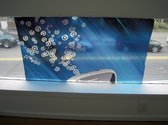

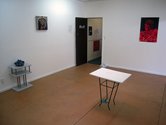
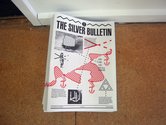
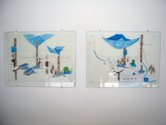
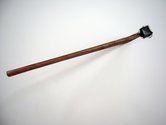
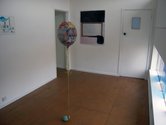
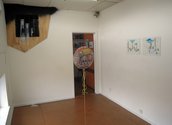


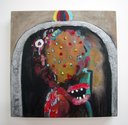


 Advertising in this column
Advertising in this column Two Rooms presents a program of residencies and projects
Two Rooms presents a program of residencies and projects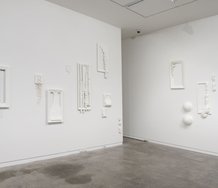
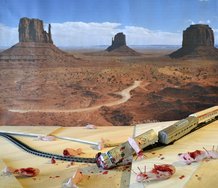
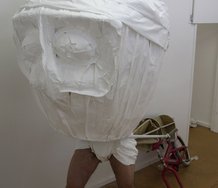

This Discussion has 0 comments.
Comment
Participate
Register to Participate.
Sign in
Sign in to an existing account.